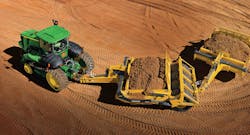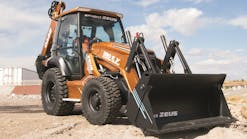Editor’s note: This article first appeared in the September/October 2016 issue of Grading & Excavation Contractor magazine.
Trenchers and excavators each have their place, but, obviously, one is better suited than the other in certain circumstances. This article addresses the kind of projects or circumstances that dictate the use of trenchers.
According to Chris Lynch, sales manager, Mining and Pipeline Group for Vermeer, excavators are still prevalent on most job sites, partly due to a tradition that so many contractors have. “This is the way they have always done it,” he says. “They have access to many excavators already for other applications, and some contractors wonder why they would ever switch.”
However, Lynch suggests that it is important to consider the advantages of trenchers in certain situations.
First and foremost, trenchers can provide efficiency, which is an important consideration, considering the often-strict deadlines imposed on many pipeline and other projects. “The purpose is often to get in there, get the job done as efficiently and cost effectively as you can, and then get out so you can do the next job,” says Lynch. “So, the fact that you can get the job done efficiently with a trencher is key. It can be the fastest way to put product in the ground.”
For example: A contractor was installing leaching lines at a mine in South America. To dig a trench in the rocky ground, crews were using four excavators and one track trencher. “The production from the one trencher was greater than the four excavators combined in the particular situation,” says Patrick Robinson, senior commercialization manager for Mining at Vermeer. “The trencher cut a cleaner trench, cut to grade, produced reusable spoil, and was faster. In addition, if you have four excavators, you’re paying for four operators and four tanks of fuel.”
Second, the quality of the ditch is often better with a trencher. That is, trenchers can provide a cleaner trench, cut to specification. With the precise cutter, a trencher can dig a trench that is equal in sizing and has clean sides and a flat bottom. “The trencher cuts exactly to its sizing,” says Lynch. “When properly sized, it only excavates the material that is necessary. It produces an even trench all the way up to the top, and the spoil can be used as backfill.”
With an excavator, there can be undulation at the bottom of the trench, and uneven walls from overdigging. If a hammer attachment is used, the trench would be trapezoidal in shape as a result of the operator starting with a narrow point, and then digging wider with a bucket to get deeper. As a result, not only is the crew excavating more material than is necessary, but also backfill is needed to get the trench to the required specifications.
Third, a trencher can potentially accomplish multiple steps in a single pass. This includes cutting the trench and producing suitable backfill. The trencher can deposit the backfill on the side of the trench, and, once the product is installed, a crew can follow behind with a dozer and push the material into the trench as backfill. An excavator, however, often produces big chunks of material not suitable for immediate reuse. Suitable backfill often needs to be hauled in, adding to the time and cost of a job. This is an even bigger issue when digging in rock. That material needs to be hauled away, processed by a crusher, and then hauled back to the job site to serve as backfill.
Another example of accomplishing multiple steps in a single pass when digging in rocky conditions is that a track trencher excels in rocky conditions with its ability to efficiently cut rock of approximately 20,000 psi and lower. An excavator bucket, on the other hand, often cannot pierce rock of that specification. That means a contractor must bring in a hammer attachment to break up the ground. Then, the crew needs to swap out the hammer with a bucket to dig the trench. Sometimes, a contractor will even have a separate machine to break the rock and another to dig the trench. Either way, that is extra time and equipment at the job site.
“It can be a huge cost to the contractor to handle backfill that way,” says Lynch. “On some jobs, it can be more expensive than the cutting of the actual trench.”
Matt Hendry, a product consultant with John Deere Excavators, also sees the value of trenchers in certain situations. “Trenchers are very productive at opening up long runs of shallow to medium depth trench,” says Hendry. “An example would be cross-country pipelining where the trench depth is around six feet.”
As Hendry sees it, the advantages of trenchers are:
- The width of the trench is consistent.
- The spoil pile is evenly spread by the trencher.
- There is fine material for each backfill, and usually no need of paddling material to backfill over the pipe.
- The trencher moves less material than an excavator because of the width of the trench.
- Trenchers work in rock or tightly cemented soils (deeper trenches). In these cemented soils, the walls will remain vertical for ease of laying in pipe. In these applications, the trencher carves the trench often to depths of 16 to 24 inches. The benefits of the trencher are clean trench walls and nicely graded spoils.
- The trencher can use GPS to keep on grade, if necessary.
According to Warren Anderson, product manager–Excavators and Dumpers, for Wacker Neuson Sales Americas LLC, when you need to bury something relatively small, you would use a trencher, because a trencher can cut smaller trenches than an excavator can. “Trenchers are primarily used when it is not important to excavate and move the material you need to dig down into,” he says. “Laying pipes or irrigation lines, and burying electrical lines are all good candidates for a trencher.”
As Kurt Moncini sees it, though, trenchers are typically very specialized equipment with limited application scope. “These typically include narrow trench widths, confined spaces, shallow depth, and small jobs,” says Moncini, senior product manager, Tracked Projects, for Komatsu America Corp.
For contractors who don’t want to invest in standalone trenchers, there are companies that manufacture trencher attachments, which can also prove valuable in the field.
“A trencher attachments works great for installing downspout drainage lines, electric cable, water lines, or anything else under six inches in diameter,” says Ron Peters, product manager, EDGE Brand Attachments, for Manitou Americas. “Trenchers can be one of the most common attachments for skid steers and track loaders.”
Various chain types are available to suit the soil type and size of the project, according to Peters. Single-standard chains are recommended for loose, damp soil. Double-standard chains are recommended for harder, drier soil. Half rock and frost chains are recommended for even harder, frozen, and rocky digging conditions. They are commonly available in 24- to 60-inch digging depths and 6- to 12-inch trench widths.
According to Katie Pullen, brand marketing manager for CASE Construction Equipment, the company does not manufacture standalone trenchers, but two of its primary product lines, skid steers and compact track loaders (CTLs), can operate trencher attachments that perform a job similar to a trencher. “Using a skid steer or a CTL with a trencher attachment is the most compact of heavy equipment trenching options, and may actually allow contractors to trench in areas that may be difficult for a walk-behind or standard trencher to reach, such as harsh terrain,” she says.
Skid steers and CTLs provide that ability, and CTLs in particular provide low ground pressure and allow for trenching to take place without tearing up much of the surrounding area. CTLs also provide a stable platform for smooth travel when pulling a trenching attachment.
While trenchers can be useful in a lot of situations, they may represent just one option, in that excavators can also be used. However, there are actually some situations where it is necessary to use a trencher instead of an excavator.
One situation can be when dealing with rock. “Today’s excavators, with the right type of ripper bucket attachment, can dig about 95% of cemented rocky soils and/or rock that has traditionally been the domain of trenchers,” says Deere’s Hendry. “It is the remaining 5% of rock where the trencher is the right choice. The trencher or rock saw can carve some very hard rock. An example is the very hard blue limestone rock in Austin, Texas.”
A long extended run of shallow trench is another area where the trencher is going to excel and be tough for an excavator to match up, according to Hendry.
According to Wacker Neuson’s Anderson, size is also a determinant of when a trencher will be necessary. “If you are in a smaller area where a compact excavator will not fit, a trencher will be able to work there,” he says. “In addition, if spillage is an issue, the trencher will create less loose earth to have to clean up at the end of the project.”
And, according to Manitou Americas’ Peters, with a trencher, the contractor will disturb less ground, which means less time required to repair grass or driveways.









